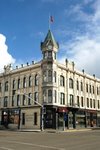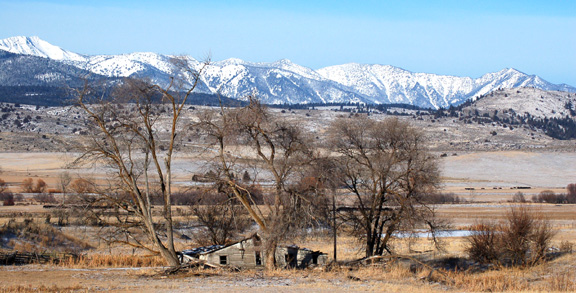I attended and filmed the special Baker City Public meeting on the Cryptosporidium outbreak tonight [8/8/13]. I came away with more questions than answers as to how Baker City is to proceed in dealing with the crypto problem. I am going to make this short, certainly not an exhaustive account of what occurred, as downloading and processing the video takes quite a bit of time for an almost 3 hour meeting, and I need to review it. It will take additional time to produce any YouTube videos. So this will be a rather bare summary and outline, and just what I consider to be the most important points until I decide to go to sleep (which won't be long)--video and most analysis will come later. (This account is from notes taken and memory as I was trying to film the event, so I will correct any errors after I am able to review the video.)
Mayor Langrell opened and explained the nature of the meeting before turning it over to City manager Mike Kee who presented the agenda and provided a summary timeline that was similar to the information in his August 2, 2013 Weekly Update. He also provided the results of the Cryptosporidium tests that have occurred during the Crypto "crisis."
Here is the video of City Manager Kee's introduction. It is somewhat dim and grainy due to low light on Baker City High School auditorium stage but best video possible under the conditions and the audio is acceptable. Best watched on YouTube by clicking this link:
Crypto Meeting Intro, Baker City, OR 080713
Alicia Hills, from the Baker County Health Department, spoke about the 15 confirmed Crypto cases and the "About Cryptosporidiosis" flyer that has been made available to residents and visitors which lists recommendations and suggestions for staying safe during Baker City's Crypto crisis. You can find the flyer here.
Michelle Owens, Director of the Public Works Department talked about the need for water use curtailment, while reminding everyone that this is a great community to live in. ;-)
Heidi Dalton talked about the decision to keep the Sam-O-Swim pool facility closed because the risks of keeping it open were too high. They will do the usual September maintenance during the current closure period.
Bill Goss from the Oregon Health Authority Drinking Water Program said that the outbreak was a naturally occurring event and that no one was to blame. He indicated that no one could predict when the no boil order would end as they will need tests results indicating that there are essentially zero Crypto oocysts in the water supply. He stated that an ongoing monitoring plan for Cryptosporidium will be instituted until a treatment facility is constructed that provides for 99.9% removal of Cryptosporidium oocysts, and that is must be in place by October of 2016. (The issue of why monitoring had not been continued after the initial round of testing ended in 2011 was brought up by citizens during the meeting.)
To the best of my knowledge, Mr. Goss did not mention at this time that the state will be reviewing out treatment options which could result in the state imposing a treatment plan different from the 99.9 % effective UV treatment plan they had already recommended.
Michelle Owen talked about solutions to the Crypto problem that the city was looking at. These included:
- Long-term plan for UV treatment of Cryptosporidium.
- Mid-term solution of finding or drilling additional supplementary water from wells (Wells are generally not be affected by Cryptosporidium.
- Short-term solutions that include boiling, and borrowing a portable non-validated membrane filter unit.
- Complete design and sighn-up contractor in early spring or earlier
- Begin construction in the summer of 2014
- Complete construction in summer of 2015
Mayor Langrell moderated a Q and A session with the audience but first discussed issues presented by some questions that had been submitted in writing by the audience. The ones he mentioned primarily had to do with whether the city [and its citizens], had a responsibility to compensate businesses that have suffered losses due to the present crisis.
Some citizens related the problems they had encountered while suffering from Crypto, and asked why the city had delayed moving forward with UV treatment when we were told as early as 2009 that treatment was required. One of these, Linda Wall of Baker City, also had members of the large audience raise their hands if they had been dealing with the symptoms of Cryptosporidiosis. She estimated that about 1/4 to 1/3 of those present raised their hands.
Former Councilor and Judge Milo Pope laid the responsibility for delay on Former Mayor and current Councilor Dennis Dorrah (who did not attend the meeting), Councilor Roger Coles, and other Councilors who had delayed providing treatment.
There were many more interesting public comments that I will try to post as a YouTube video later.
The bottom line, in terms of how we will move forward came when Councilor Coles gave a spirited rebuttal to Milo Pope's comments and then Mayor Langrell validated Councilor Coles comments that he couldn't see going forward at the time because DEQ might suddenly change the requirements in the future, even though Mayor Langrell had spoken about the accelerated schedule for UV earlier. I commented that I thought using that sort of speculation was a scare tactic and that given EPA approval of UV and current state direction there was no basis for it. Then, perhaps in response to questioning on that point by Councilor Mosier (have to check the video), Bill Goss from the State Health Authority said that a change in requirements was a possibility because the state was going to review the present outbreak and could possibly change their recommendation to the much more expensive $17M to $20M water filtration requirement and plant that costs over $300,000/year to maintain.
I pointed out that we had spent the meeting talking about installing UV treatment, that is what the state has told us we need to install, and that filtration would cost significantly more than UV to install and maintain. I misspoke the figures as being in millions rather that thousands, but the point was that maintenance costs are still something like 25 times greater for filtration than for UV treatment, according to the 2009 figures provided to the city by HDR.
When I asked him after the meeting about this announcement, after 80% of the meeting had been about the accelerated schedule for constructing the UV treatment plant, he told me that his announcement had been timely as the outbreak had only been going of for a few weeks, and he was there to talk about other things (i.e., the boil water order). We discussed a few other issues related to the state's review, but it is late so those will be discussed later, as will numerous comments by a very engaged audience.
Given the late announcement of a state review, which Mr. Goss said will take about two months (or possibly 6 month to a year), I am at a loss to understand how the earlier presentations about an accelerated schedule for the installation of a UV water treatment facility were allowed to be presented, how they can move forward or be accomplished, and I am beginning to understand why local governments do not trust regulatory bodies like the DEQ or the Oregon Health Authority. How can Councilors or staff, left in limbo, commit resources to any solution, when the regulatory agencies reserve the right to waste the time and resources communities have committed by changing their mind--especially when such regulatory changes can bring financial ruin to many low income citizens and potentially even the to cities they live in?
One searches for answers as to why the the feds and the state would impose such confusion and uncertainty on the cities and towns they have been given authority over when there are adequately safe, rational, and affordable solutions to the problems being faced. I also wonder if it isn't becoming clear that many government workers, from the federal to the local level, including as well some of our other financially comfortable citizens, have not simply become completely insensitive to the world and needs of low income people. I heard the folks tonight (now last night) who told their stories of not having health insurance and not being able to afford to go to the doctor, and some of those who could go to the doctor, couldn't afford the medications they needed to treat the cryptosporidiosis they suffered from. With the new push to force selection of unaffordable water treatment options, it is not clear whether some state, county, and city officials care if low income people can afford the quest for guaranteed safety at any cost that some of the comfortable apparently seek, and which ultimately places burdens [I. e., increases in water/sewer rates] on the poor that they cannot bear. Perhaps the regulators, developers, realtors, newspaper peddlers, merchants, and the wealthy, see an opportunity in ridding themselves of poor people by making their towns into places where the poor can't afford to live any more. A kinder, gentler, saner solution would be for them to buy a membrane filtration unit for their home and save the rest of us the expense of providing them with an incredibly small extra margin of safety.














